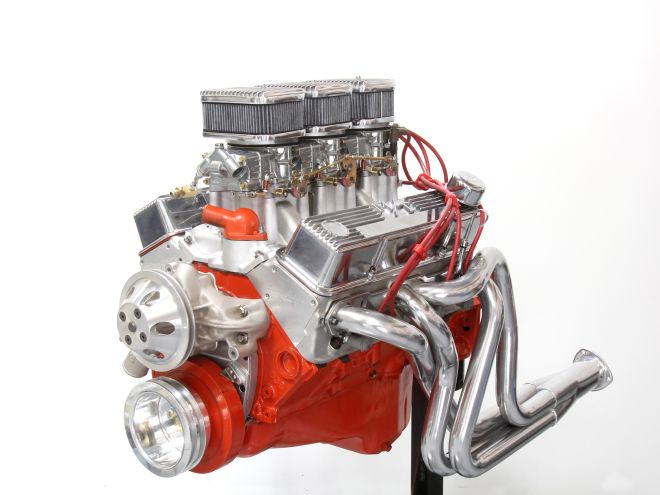
Long ago, a wise man once wrote that what was once old will become new again. He might have been talking about women's fashion or perhaps he was just a street rodder who has seen the march of high-performance hemlines make a splash, depart, and come 'round again. In this particular case, it is the allure of the three-deuce setup that has never really left. Before the dawn of high-flow, big-cfm carburetors, the only way to introduce more air and fuel into the engine was to bolt on more carburetors. U-Fab intake manifolds and six symmetric carbs morphed into three two-barrels. Even as late as the early '70s factory Mopars were intimidating with 6-Pak induction systems. Face it, Tri-Power systems are just plain cool.
So here we are, in the 21st century of EFI and all things digital and what is one of the hottest products to come out of Holley's old Kentucky home but a complete throwback, bolt-on three-deuce (Tri-Power) setup for a small-block Chevrolet 350/290 crate engine, and we couldn't be happier. So when the opportunity came around, we convinced the UPS guy to drop off a box of very cool pars at our shop door.
Let's spend a moment and look at exactly what makes up this Holley kit. The intake is a Weiand dual-plane piece that offers just enough real estate to mount a trio of carburetors. The manifold squeezes a center Holley two-barrel rated at 325 cfm with outboard carbs flowing 350 cfm. If our math is right, that totals an overkill of 1,025 cfm, which is more than enough to feed even a maniacal small-block. Because these are model 2300 two-barrels, they use Holley four-barrel guts so if you feel the need to tweak, each carb is the same as the primary side of a 4150 Holley four-barrel.
In a way, this kit is a little like your daughter's fifth Christmas where Santa insisted on delivering a five-room dollhouse in which the box proclaimed in small type "Some Assembly Required." Yes, you have to put this three-deuce package together, but it's not difficult—if you follow the instructions. We'd suggest reading them because the tips offered will save you some grief.
The fuel rail kit alone is well worth its cost just for the ease of assembly. We considered creating individual fuel lines for each carb on the dyno so we could separate the fuel flow but because the clearance between the carbs is so tight, it will take some custom fabrication should this be your plan. For the rest of us mere morals, the stock pre-bent stainless 5/16-inch fuel lines and brass fittings bolt right on with no hassle. Here's another hint, install the center carb first because it's challenging to nestle the center carb in place once either end carb is installed.
The three-deuce package also comes with an equally easy linkage kit that delivers a staged throttle opening. We discovered during the assembly that it was essential to ensure the center carb opens fully. Don't stress over achieving a 100 percent opening of all six barrels—with over 1,000 cfm on tap, the carburetors will not be the restriction.
Once we bolted the three carbs to the intake, we glued the new intake down to our Great Crate small-block Chevy to evaluate just how much power we're looking at. You might remember from Great Crate Part III that we slid in a mild 236/242-degree COMP hydraulic roller cam into the engine that was already blessed with a set of Edelbrock Performer RPM aluminum heads. That package produced a reliable 424 lb-ft of torque at 4,000 rpm and 431 hp at 6,000 using an Edelbrock Performer RPM dual plane intake and a 750-cfm four-barrel carburetor. We really didn't expect the Tri-Power to exceed the previous test's numbers as this three-deuce setup is a nod toward image as anything else. We just wanted to see what kind of power we could make in comparison to our last outing with the Great Crate small-block.
In keeping with the retro theme, we also added a pair of '60s vintage Mickey Thompson finned valve covers from Holley and the combination of the Tri-Power and the valve covers gives our little small-block a decidedly throwback appearance. If we wanted to carry this theme all the way through, we would probably ditch the aluminum two-piece timing cover and go back to a steel version and a short water pump. The valve covers did require knocking out the plug on the passenger side to add a PCV valve connection. Unfortunately, the fitting in the back of the intake manifold is too close to the distributor to be of any use. Our thought was to drill a hole in the back of the rear carburetor base plate for a PCV/power brake outlet that would be far more accessible.
The only real change we had to make when using the new 3x2 manifold was that the original HEI distributor would not clear the manifold. This demanded we return to a small-cap distributor. There's a limit even on nostalgia engines as to what we'll put up with and we draw the line at points distributors. Certainly a points-conversion unit like the one from Crane or a PerTronix would work. Instead, we decided to step up to an MSD Street Pro-Billet that requires both a CD box (like the 6A) and a coil. If room is extremely tight, you can also opt for MSD's Pro-Billet small diameter distributor that is 1 inch shorter and 3/8 inch smaller in diameter than the normal distributor but this housing is sans vacuum advance. Along with a set of MSD plug wires, we altered the advance curve slightly to deliver 15 degrees of initial and 21 degrees of advance to make 36 degrees of total timing and with that we were ready for the dyno.
With the engine firmly bolted to Westech's engine dyno cell, the first test revealed a distinctly rich air/fuel ratio. Eventually, we reduced the jetting on the outboard carburetors from 70 to 64 and leaned the center carb from 65 to 61. This produced the best overall WOT fuel curve, although it was still a little fat at the lower engine speeds. We also tested the part-throttle cruise air/fuel ratio and that was also a bit rich at 11.8:1 but that could be improved with some idle feed restrictor work on the center carburetor.
Once we completed the jetting and timing procedures, our best overall power test produced a peak of 411 hp at 6,000 and a top torque number of 405 lb-ft at 4,000 rpm. These numbers are short of the single four-barrel test (431 hp and 424 lb-ft of torque). However, the power graph reveals that below 3,500 rpm the 3x2 manifold made significantly more torque; as much as 18 lb-ft more at 2,900 rpm where the engine spends a lot of time. Plus, the loss of power compared to the single four-barrel carburetor is all at the higher engine speeds and the consensus of the dyno crew was that sacrificing 20 hp at the top of the curve is more than offset by the system's excellent nostalgic appearance. As an overall evaluation, we'll give the system a hearty thumbs up with a special gold star for achievement with the fuel lines. Try to recreate these lines yourself and you'll understand why. We did give up a little power compared to a single four-barrel, but this barely justifies the criticism. Bolt on this 3x2 package and then sit back and let your friends' heap on the praise. Drool cups are optional.
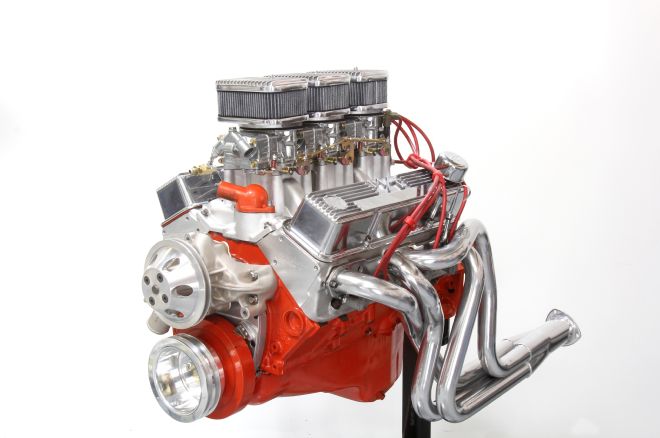
01 Our Great Crate small-block now sports a distinctly retro look with Holley's new Tri-Power 3x2 system, complemented with a pair of Mickey Thompson finned valve covers also from Holley. Total airflow with these three carbs is 1,025 cfm, so there's a tidbit you can add to your bench race factoid list.
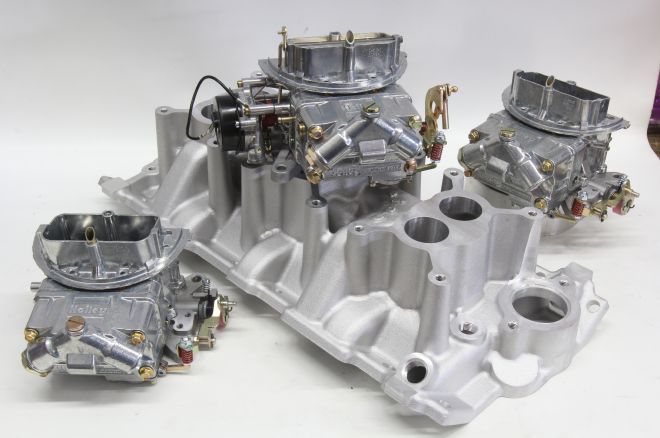
02 These are the four main components to the Holley Tri-Power kit. All three carburetors are 2300-style Holleys with the center mixer rated at 325 cfm while the other two flow slightly more at 350 cfm. These are the cast shiny finish, but the more retro dichromate finish carbs are also available.
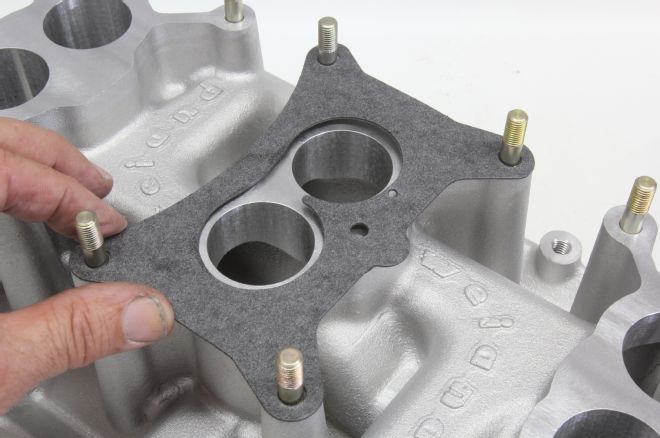
03 The kit has to be assembled and you can make the process less painful by installing the base gaskets correctly in this fashion. Install them backward and you will be rewarded with a massive vacuum leak.
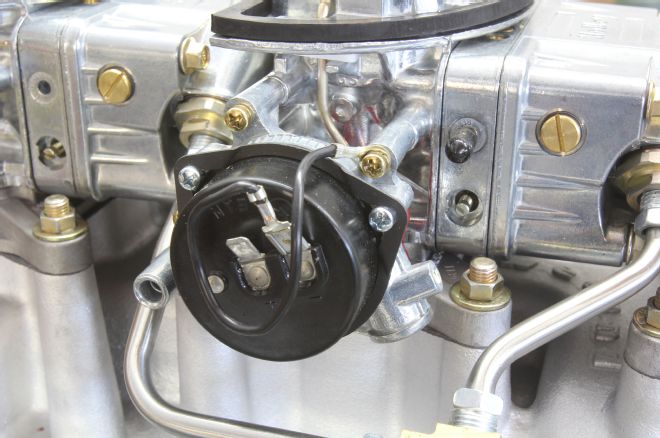
04 The center carburetor is equipped with an electric choke, which makes cold starts easier. Make sure to supply full-switched voltage to the choke to ensure proper operation. If 12 V is not supplied to the choke, it will not fully retract and the engine will run rich.
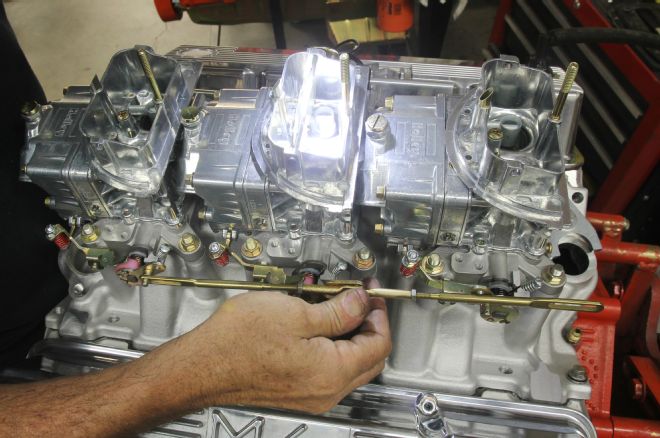
05 When installing the linkage, the outboard carbs can be adjusted to begin opening at approximately one-third primary throttle. Also check to ensure that all three achieve near full throttle.
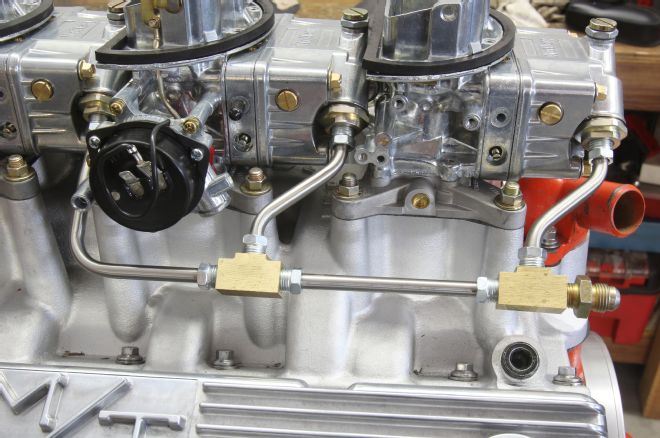
06 The supplied pre-bent stainless, 5/16-inch fuel line not only complements the Tri-Power's vintage look but also installed on the first try. The trick is to leave everything loose until all the threaded fittings are full engaged.
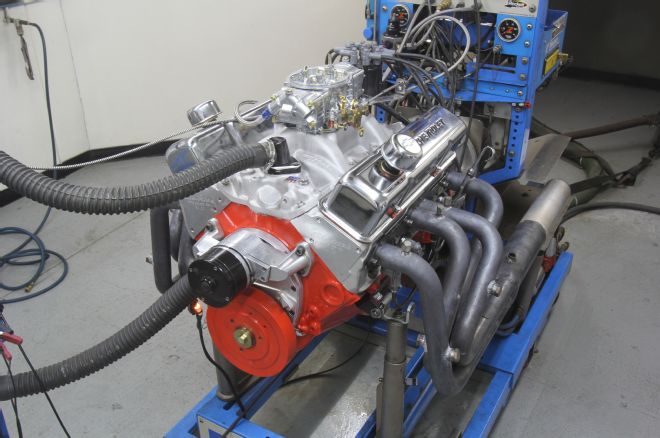
07 This was the Great Crate's previous configuration with the Edelbrock Performer RPM intake and Holley 750-cfm Holley HP carburetor that we will use as our baseline for comparison.
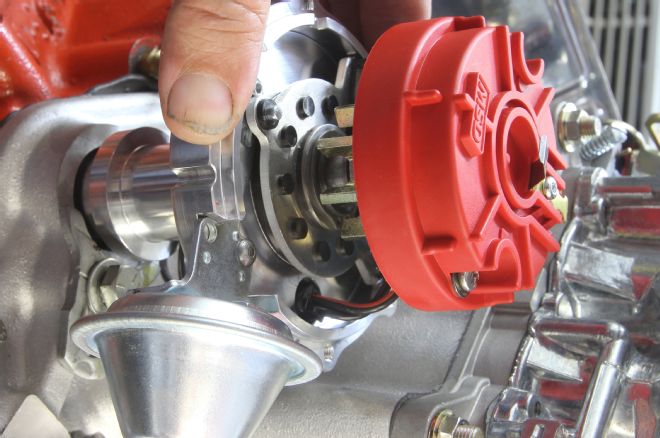
08 The Tri-Power manifold is long enough that a large-cap HEI will not fit so we opted for an MSD Street Pro-Billet distributor with vacuum advance that will clear. The Blaster 2 coil has to be mounted externally from the engine, as there's no room on the manifold. This distributor requires an external CD box as well. We rounded out the package with a new set of MSD plug wires and Autolite plugs.
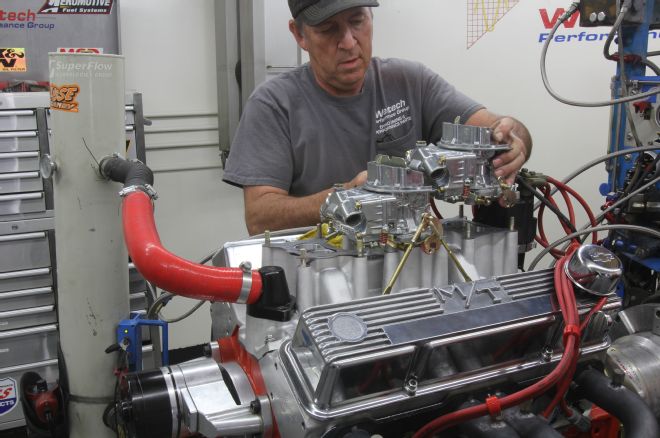
09 With stock jetting in the three Holley carbs, we optimized total timing to suit this new induction system but very rich readings dictated some re-jetting. This requires removing the outboard carbs and loosening the center in order to R&R the outer carbs on the manifold. It's not a big deal, but does take longer.
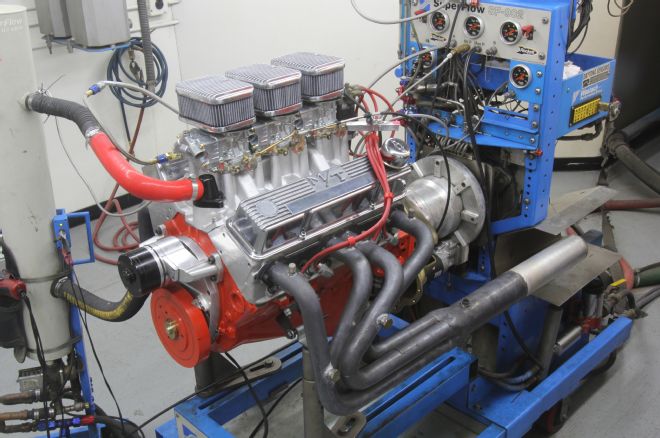
10 We also tested the engine with the air cleaners to see if they represented a restriction but both torque and horsepower were unaffected. Plus, they look great and repeat the finned theme.
Cam Specs CamshaftAdv. DurationDuration at 0.050Lift (inches)Lobe Sep. Angle XR-288 Intake2882360.520 110 XR-288 Exhaust2942420.540 --- By The Numbers RPMTQ1HP1TQ2HP2 2,600333165340169 2,800328175342182 3,000334191352201 3,200353215369225 3,400376243382247 3,600397272393269 3,800412298402291 4,000421320405310 4,200424339404323 4,400421353403338 4,600418366402352 4,800413378400366 5,000408388396378 5,200404400393389 5,400401412388399 5,600395421381406 5,800388428371410 6,000377431360411 6,200364430347410 Peak424431405411 Avg.387.3323.9380.5316.4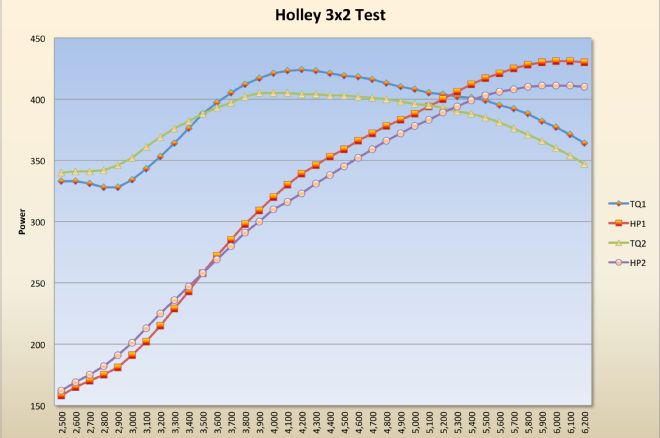
Note that averages and peaks were referenced from the full test of every 100 rpm, so the average numbers may not agree with the every-200 rpm numbers shown in this chart.
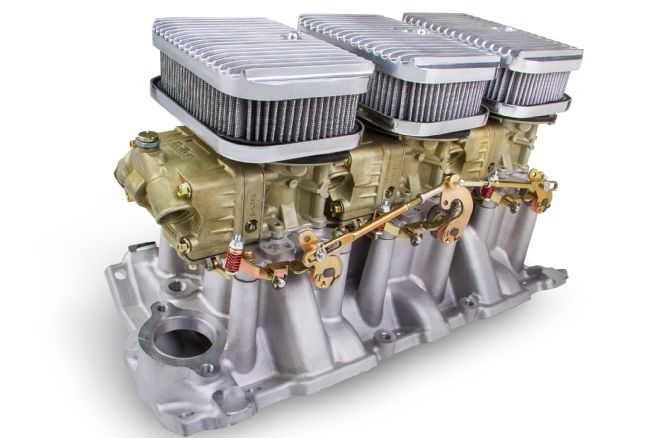
11 Also available from Holley is the new Chevy Tri-Power system available in a dichromate finish as well as polished.
Adjustable PVC
Not everything that you might consider useful for a street engine makes more horsepower. Consider the lowly positive crankcase ventilation (PCV) system. It's not glamorous, it doesn't make more horsepower, and it's not exactly an essential style element. When PCV valves work correctly, they introduce a slight amount of vacuum in the crankcase to pull oil vapors out of the engine where they can be combusted. But that's only if the valves are properly sized. A company called M/E Wagner has done some testing and found the stock PCV valve pulls very little vacuum at idle or during cruise, which is why you often see a light oil film around the valve cover grommets where crankcase pressure has pushed vapors out of the engine.
M/E Wagner has created a slick dual adjustable, billet aluminum PCV valve for most street engines that allows you to determine the amount of vacuum introduced into the engine at both idle and at cruise engine speeds. This allows you to create the right amount of vacuum, which minimizes the crankcase vapors and draw out water and fuel vapors out of the engine and keeps the inside clean. This vacuum also keeps the outside of your engine cleaner.
On the company's website, they've listed the results of a driving test where they evaluated three stock PCV valves and an aftermarket "dress-up" PCV valve where only one valve introduced vacuum in the pan more than 50 percent of the time. The other two were capable of much less with the worst—was capable of barely 3 percent time under vacuum. The test procedure was a 17-mile driving cycle at part throttle with roughly 1 percent of the time at wide-open throttle (WOT). When the M/E valve was tuned for the engine and then tested, it placed the crankcase under vacuum for 99 percent of the time.
M/E Wagner's 90-degree PCV valve is a billet aluminum piece that is completely adjustable. The machine work is exceptional and is also configurable as an inline valve with an optional billet end piece. The unit comes with full tuning instructions and it only takes a few minutes to have this unit up and running. Because it is tunable and is somewhat complex to build, it is much more expensive than a standard PCV valve.
A larger volume of crankcase vapor can be extracted using this tool so you might want to also think about adding a crankcase oil vapor separator like a Moroso air-oil separator when using this adjustable PCV valve. This allows you to keep the engine clean while not pulling excess oil into the intake. The M/E Wagner PCV valve is another way to make your hot street engine run cleaner and last longer.
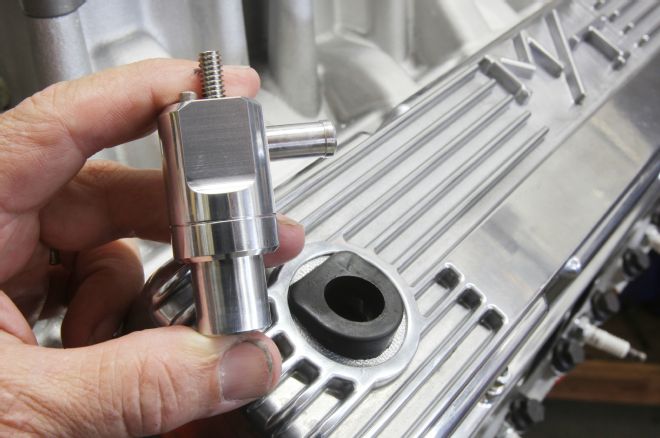
12 This is the M/E Wagner PCV valve. A complete PCV system requires the valve be placed in a baffled valve cover with a filtered inlet on the opposite cover. The M/E Wagner valve offers independent adjustment for both idle and cruise situations to maintain a vacuum in the crankcase.
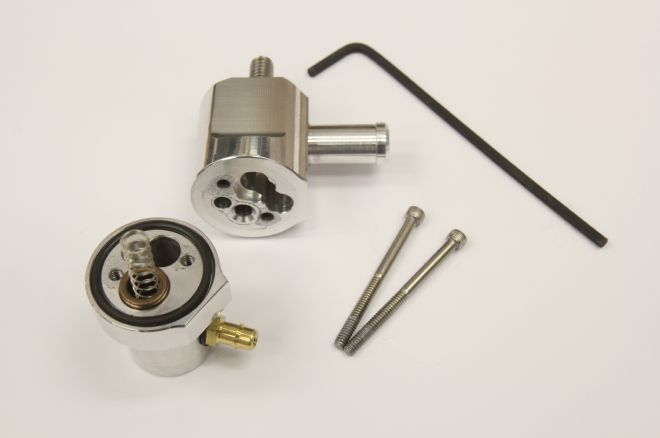
13 This is the disassembled the M/E Wagner PCV valve revealing the two separate idle and cruise passages.
Parts List DescriptionPNSourcePrice 290hp Crate engine12499529Summit Racing$2,069.97 Holley 3x2 SBC carb kit, dichromate300-521Summit Racing1,999.95 Holley 3x2 SBC carb kit, shiny300-522Summit Racing1,899.95 Holley 3x2 manifold, SBC7550Summit Racing381.95 Holley Center carb, 325 cfm, shiny0-80683-1Summit Racing335.95 Holley outboard carb, 350 cfm (2)0-80684-1Summit Racing299.95 ea. Holley air cleaner kit, billet aluminum1200-105Summit Racing299.95 Holley fuel 3x2 fuel line kit34-51Summit Racing109.95 Holley 3x2 throttle linkage kit20-42Summit Racing149.95 Holley 3 x2 air cleaner gasket set108-127Summit Racing44.95 COMP cam kit, XR288HR hyd. Roller*K12-433-8Summit Racing903.97 MSD Street Pro-Billet distributor8361Summit Racing259.95 MSD V-8 universal plug wire kit31229Summit Racing90.95 MSD digital 6A capacitive discharge 6201Summit Racing209.95 MSD Blaster 2 coil8202Summit Racing47.95 Fel-Pro intake gasket1256Summit Racing 17.97 Holley retro valve cover set241-82Summit Racing162.95 Dual Flow adjustable PCV valveDF-17M/E Wagner129.00 Moroso universal air-oil separator85496Summit Racing134.97